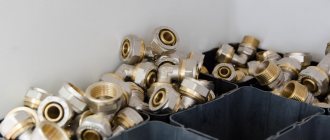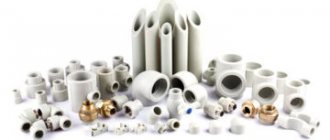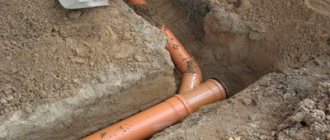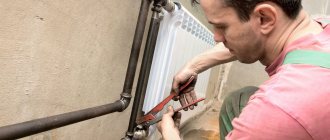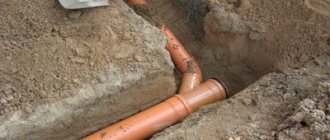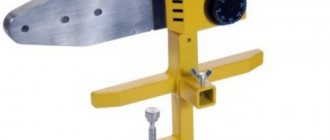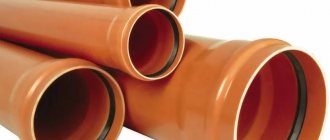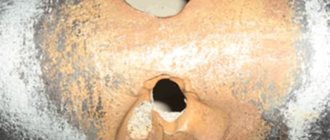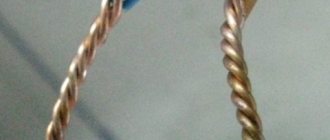The connection of metal-plastic pipes is made using compression fittings for clamping and their analogues for crimping. Installation of pipelines in both cases does not require sophisticated equipment or highly qualified specialists.
The first method is easier to implement, but not as reliable. But press fittings for metal-plastic pipes make it possible to create a durable system with minimal risk of rupture.
What is a compression fitting
Installation of metal-plastic pipelines cannot be done by welding or gluing; for this purpose, the method of mechanical crimping is used. There are two types of connections - permanent and detachable.
For the first type, press fittings are used. Permanent connections are made mainly in closed utility networks mounted under the floor or in the wall. They do not require periodic maintenance. They are carried out using a special tool called press tongs.
Crimp, or compression, fittings are used for detachable connections, the most common today. They do not require expensive tools, just a few wrenches.
Design Features
Detachable connections are used, as a rule, for the installation of open pipelines, as well as for connecting any working devices.
Compression fittings consist of the following parts:
- Union nut.
- Crimping ring (cracker, collet).
- O-rings made of EPDM (ethylene propylene diene rubber).
- Teflon dielectric gasket.
- Fitting body.
- Restrictive collar.
- Stock.
An appropriately prepared metal-plastic pipe is placed on the rod of the product. This is done all the way to the dielectric gasket, which is used to limit stray currents.
O-rings serve to enhance the tightness of the system under the influence of internal pressure. The union nut uses a cracker to compress the metal-plastic pipe onto the rod.
When installing crimp connectors, you do not need to use expensive tools; you only need scissors, a calibrator, a chamfer and a set of wrenches. If necessary, the fittings can always be disassembled and the pipes can be reconnected with them. With proper installation and operation, compression connectors will last a long time.
The disadvantage of such parts is the need to constantly monitor their condition and periodically tighten them.
Prices for compression fittings
compression fitting
Preparing pipes for processing with press jaws
Immediately before assembling metal-plastic systems, i.e. Before using press jaws and carrying out crimping activities, the pipe material is prepared accordingly.
When marking metal-plastic pipe material, it is necessary to add a small overlap (2-3 cm) to both ends of the part. Otherwise, after inserting the fitting, the fragment will be shorter than required according to the estimate. The position of an incorrectly installed press fitting cannot be corrected. You will have to cut out the entire fragment and install a new one in its place.
The sequence of actions is relevant for any type of tool and requires mandatory compliance:
- Using a tape measure, measure out the required amount of pipe material from the coil and make a mark with a marker where the intended cut will be.
- Using scissors for cutting metal-plastic, cut off a part of the required length, making sure that the resulting edge is as smooth as possible and makes a clear right angle with the conditional central axis of the product.
- When using a guillotine tool for work, its lower edge is held strictly parallel to the surface of the pipe, only slightly pressing the cutting part into the pliable material.
- When the trimming is done, the resulting end edges are processed with a calibrator. He corrects and aligns the shape of the cut and carefully removes the internal chamfer.
- Remove the ferrule from the fitting and place it on the edge of the pipe. The fitting is inserted directly into the cut.
- The end parts of the connection elements are pressed tightly, and the joint area is isolated with a sealing gasket. It protects the material from corrosion and ensures the tightness of the entire system as a whole.
- The placement of the pipe in the sleeve is controlled through a round cutout in the edge zone.
When the appropriate preliminary preparation is completed, proceed to the use of press pliers and carry out the crimping operation.
Types of fittings
During operation, pipeline systems change the direction of movement, branch, are plugged, attach some devices or change the diameter. All these problems are solved using assembly elements. Each such detail, depending on its purpose, has its own shape.
Types of fittings:
- Bends. Change direction of movement by 45, 90 or 120 degrees.
- Couplings. Connect two pipes of the same diameter.
- Plugs. Close the dead end.
- Tees, Crosses. Used to create branches.
- Fittings. Designed for connecting a flexible hose.
For installation of pipelines of different diameters, adapter couplings are used. Elements connecting pipe sections with identical holes are called straight.
Installation of metal-plastic pipelines
There are two main points that you need to know and apply when installing metal-plastic pipes - how to connect and how to install:
- Fastening must be done using special clips of the required size.
- During installation, the integrity of the top coating of the pipe must not be damaged; to do this, check the fasteners for the absence of burrs.
- A metal-plastic pipe can be bent, but when installed in a right angle, it is necessary to use special inserts to prevent deformation and narrowing of the pipeline cross-section at the point of bending.
- During installation, do not allow sudden jerks of the elements, this may lead to loss of tightness of the connection.
If you are not confident in your construction abilities, entrust the installation of the pipeline to a professional contractor.
What materials are they made from?
For the manufacture of assembly elements the following are used: cast iron, steel, copper, bronze, brass, plastic. It is believed that when installing utility networks, the materials of pipes and connecting elements must match each other.
Cast iron and steel assemblies are used to connect carbon steel pipes, bronze and brass – for copper, and plastic – for polyethylene. Since metal-plastic pipelines are connected by mechanical crimping, the materials for the manufacture of parts must be ductile and durable.
Compression fittings for metal-plastic pipe products are made from:
- brass (an alloy of copper and zinc), coated with nickel or tin;
- of stainless steel.
Brass products have higher corrosion resistance, but they are also more expensive than stainless steel assemblies. The body and union nut of the assembly device are made from these materials. O-rings are made from synthetic rubber (EPDM). The crimp ring is made of stainless steel or Teflon.
When installing the collet, the outer layer of the pipeline casing must not be damaged.
Advantages and disadvantages
Press fittings have already proven themselves as reliable and durable fasteners for metal-plastic structures.
Let's look at other positive aspects of using press fittings:
- The operation of the system does not require monitoring or additional maintenance. You can install a hidden pipeline, or completely fill the system with cement.
- When temperatures fluctuate, there is no effect of pipe expansion. Thanks to this, press fittings can be used for pipes supplying hot water.
- Quick installation. In order to install such a system, it is enough to arm yourself with special press jaws. No special skills are required for installation.
- There is no need for a large amount of fittings. Pipeline installation is simplified. Material costs are reduced.
In addition to the advantages, however, there are also some disadvantages of press fittings:
- "Disposability" of the system. This structure cannot be disconnected. If the press fitting is pressed incorrectly during installation, the only thing you have to do is disconnect it and throw it away.
- Brass products tend to become covered with an unpleasant patina and darken over time. However, users advise covering such a structure with nickel or chrome to make it decorative.
- Press connections made of brass are designed to operate at a pressure of 16 atmospheres. But in city apartments the pressure mainly varies within 2-3 atmospheres.
Criteria for selecting compression fittings
In order to buy compression fittings for metal-plastic pipes, you should go to a specialized store. When purchasing such parts, you must pay attention to the presence of a quality certificate.
This document should reflect the following parameters:
- Manufacturer's warranty.
- The maximum pressure and temperature for which the connectors are designed.
- Material and weight of the product.
The device markings must be clearly visible. The product should be checked for weight. If the part is too light, it means that another alloy, mainly aluminum based, was used instead of brass or steel.
Be sure to check product reviews online. Very often, manufacturers use cheaper raw materials, thereby reducing the cost of products, but at the same time the quality of the product deteriorates. To obtain a reliable pipeline, you do not need to strive for excessive savings and always remember that high-quality products cannot have a low cost.
In practice, it has long been proven that pipe products made of metal-plastic and assembly elements must be from the same manufacturer. There are good reasons for this. Pipes and fittings from different manufacturers can differ in size by literally a millimeter. This is quite enough to reduce the reliability of the connection.
There is no common standard for all manufacturers for the shape and dimensions of assembly elements. Each company has its own parameters for tubular products and assembly devices.
Watch a video on how to select a fitting.
Features of using press jaws
Despite the practicality and functionality of press pliers, there are places where using such a tool is very inconvenient. Repair and installation professionals say that when working with grooves laid in a false wall or under a suspended ceiling, it is wiser to take a press gun rather than pliers. It completely eliminates injury and makes it possible to control the process with one hand.
A pressing gun is a modern, convenient tool that allows you to crimp pipe material in the most inconvenient places and in limited spaces. However, it is not cheap and it is not advisable to buy it for one-time household work.
In addition, the tool can be rotated around the joint axis of the pipes, thus performing accurate, even and reliable crimping.
Practical tips for crimping metal-plastic pipes, tested in practice by plumbers, are given in the following article, the contents of which we recommend that you familiarize yourself with.
Step-by-step instructions for connecting a pipe with a fitting
The installation of compression assembly elements can be carried out by any untrained person, provided that the technology is carefully followed. To complete the job, you will need a pipe cutter, a calibrator and two wrenches from the tools. Before installation, it will be necessary to straighten the metal-plastic pipe.
Main stages of work:
- Measure a piece of pipeline of the required size and cut it with a pipe cutter or a hacksaw with fine teeth.
- Clean the cut area with a chamfer or file.
- Use a calibrator to restore the ovality of the hole.
- Place the union nut on the pipe first, and then the ferrule.
- Lubricate the fitting rod with silicone.
- Place the end of the pipe tightly, until it touches the dielectric ring, onto the rod of the connecting element.
- First screw the union nut on by hand and then secure it by squeezing it with two wrenches.
Avoid using excessive force when tightening the nut to avoid deforming the threads or crushing the O-rings. After the system is assembled, it is necessary to carry out testing by filling it with working fluid. If a leak occurs, re-tighten it.
See how a pipeline is installed using push-in fittings.
Crimping rules
Despite the ease of installation of compression fittings, there are several subtleties that must be taken into account during operation. Press jaws have a set of inserts of different sizes. The crimping insert is selected according to the caliber (diameter) of the pipe. Provided that the positioner insert is selected correctly, after crimping, two identical annular strips are obtained. An insert that does not match the pipe caliber will not allow proper compression, as a result of which the joint will be leaky.
The coupling can only be crimped once. Repeated compression is prohibited. If during work the fitting was installed incorrectly, it will have to be completely dismantled and a new one installed.
The design of crimp connectors may vary slightly between different manufacturers. The main difference is the installation of the ferrule. In some models it is initially fixed to the fitting. Installation of such components is carried out in a slightly different sequence, since there is no need to install the sleeve on the end of the pipe. Immediately after calibration, the pipe is placed on the fitting and the compression process is carried out.
Cost of compression fittings from different manufacturers
Prices for compression fitting connectors depend on the type of material and weight, technical conditions, as well as the manufacturer. Today, the market offers products from both domestic and foreign manufacturers, who offer different prices for their products. Cost may also vary depending on the seller and region.
In order to choose quality products at an affordable price, you need to carefully study their parameters. Characteristics of connecting elements and information about their cost should be found in the catalogs of manufacturers and sellers of plumbing products.
For comparison: parameters and prices of compression fittings for metal-plastic pipes from various manufacturers.
| Company manufacturer | Options | |||||
| Material | Diameter, mm | Maximum pressure, bar | Maximum temperature, °C | Manufacturer's warranty, years | price, rub. | |
| Valtec, Russia-Italy | Brass, stainless steel | 16–32 | 25 | 115 | 10 | from 93 |
| ProAqua, Germany | Brass, Teflon | 16–32 | 10 | 95 | 10 | from 61 |
| Uponor, Finland | Brass, polyamide | 16–25 | 10 | 95 | 10 | from 66 |
| Ape, Italy | Brass | 16–32 | 10 | 95 | 10 | from 106 |
| Rehau, Germany | Brass, stainless steel | 16–40 | 10 | 80 | 1 | from 312 |
Safety precautions when working with the tool
To use press tongs at home, you do not need specific knowledge or extensive work experience. You just need to carefully study the operating instructions and strictly follow everything that is written there.
Do not use the tool in rooms with high humidity. Dampness has a bad effect on metal and leads to jamming and incorrect operation of tools.
It is advisable to carry out the pressing process in comfortable, practical clothes, and protect your hands with thick construction gloves. To avoid injury and damage, do not allow parts of clothing or limbs to get into the working mechanism. Following these simple rules will help you perform crimping carefully, without damaging either yourself or the tool.

